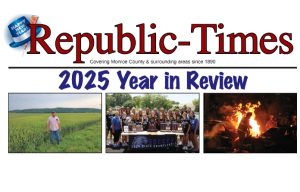Report shows status of farming
By TAMMIE SLOUP
FarmWeek
Farming continues to be a family business, with 97 percent of U.S. farms family-owned and accounting for 90 percent of farm production.
While most U.S. farms are small family farms (gross cash farm income less than $350,000), these farms operate on 46 percent of U.S. agricultural land and account for 19 percent of the total value of production.
Statistics like these are outlined in USDA’s 2023 America’s Farms and Ranches at a Glance report released Dec. 12. The annual report dives into U.S. farm characteristics using data collected from 19,100 farms in 2022.
The survey was conducted by the National Agricultural Statistics Service and Economic Research Service.
Farms, production and farmland
Large-scale family farms (gross cash farm income of $1 million or more) accounted for 52 percent of the total value of production and 25 percent of agricultural land in 2022. Midsize family farms (farm income between $350,000 and $999,999) accounted for 21 percent of agricultural land and 19 percent of the total value of production.
“We can see large-scale family farms dominate the production of most commodities, including beef, hogs, cash grains and soybeans, cotton, dairy and specialty crops, and the remaining commodities, poultry and eggs and hay, small family farms and mid-sized family farms dominate the production,” co-author and ERS Agricultural Economist Katherine Lacy said during a webinar.
Nonfamily farms accounted for the remaining 3 percent of farms, and 16 percent had a farm income of $1 million or more.
Farm financial performance
Most small family farms have an operating profit margin, or share of gross income that is profit, of less than 10 percent, indicating potentially more financial vulnerability, while most midsize, large and very large family farms reported OPMs above 10 percent in 2022.
“Compared with 2021, the percentage of small family farms in the low-risk zone increased or remained the same in 2022,” according to the report. “All other farm types showed a decline in the percentage of farms in the low-risk zone in 2022 relative to 2021.
“This could be due in part to the large increase in prices received compared to the smaller increase in input costs in 2022, resulting in record-high net farm income,” according to the report. “However, these returns were not equally distributed across all commodities.”
Off-farm income helping pay for farm expenses
Farm households, in general, were not considered low income or low wealth.
In 2022, median farm household income (including both farm and off-farm income sources) exceeded that for all U.S. households but was lower than the median income of all U.S. households with self-employment income.
As in previous years, the median total income of all U.S. family farm households ($95,418) was greater in 2022 than the median income of all U.S. households ($74,580). The median total household income for all family farms in 2022 increased from $92,239 in 2021.
“About 84 percent of all U.S. farm households earn the majority of their total household income from off-farm sources and often use off-farm income to cover some portion of farm expenses,” the report states. “As farm size increases, the percentage of households relying on off-farm income decreases.”
And while self-employment and wage/salary jobs are the primary sources of off-farm income for farm households, unearned off-farm income sources (public and private pensions, interest and dividend payments, asset sales, Social Security payments, and other income sources) provide a significant share of off-farm income relative to total off-farm income.”
Government payments and federal crop insurance
Overall, 13 percent of farms participated in federal crop insurance in 2022, with participation varying by commodity. About 62 percent of row crop farms purchased federal crop insurance. In contrast, 9 percent of farms growing specialty crops purchased federal crop insurance.
Small family farms received 78 percent of all payments from USDA’s Conservation Reserve Program, which removes environmentally sensitive cropland from production and increasingly enrolls grasslands in support of grazing operations. In contrast, 62 percent of all Natural Resources Conservation Service working-land program payments were received by midsize family farms, large-scale family farms, and nonfamily farms. These programs include NRCS’s Environmental Quality Incentives Program and Conservation Stewardship Program, both of which incentivize adopting certain agricultural production practices.
Overall, 25 percent of all farms reported receiving some type of government payment in 2022, a decline from 34 percent in 2021 and 40 percent in 2020. The decline is largely due to the tapering of COVID-19-related assistance payments, according to the report.
The report also contains two new sections: usage of credit by lender type and farm size, and the differences in farm operations by race and ethnicity of the operators.
With credit usage, about 26 percent of all U.S. farms held any debt in 2022, and the majority of farms with debt used one lender. Over half of these farms reported loans owed to a commercial bank, compared to 8 to 10 percent with loans serviced by USDA, Farm Service Agency, and 31 to 43 percent with loans serviced by the Farm Credit System.
Among socially disadvantaged farms, non-Hispanic Black farms differ most compared to non-Hispanic White farms in terms of size, specialization and financial outcomes. Non-Hispanic Black farms are more likely to specialize in cattle production and be classified as intermediate rather than residence or commercial farms. They also are more likely to have an operating profit margin in the high- or medium-risk zones and are less likely to report the use of debt.
To read the full report, visit bit.ly/41iDLK3.
This story was distributed through a cooperative project between Illinois Farm Bureau and Illinois Press Association. For more food and farming news, visit FarmWeekNow.com.






